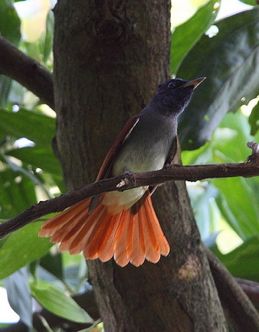Myron Tay managed to photograph the Asian Paradise-flycatcher (Terpsiphone paradisi) (above left) and Pied Fantail (Rhipidura javanica) (above right), in both cases with their tail fanned.
Myron wrote, “I have noticed that at least two birds, Asian Paradise-Flycatcher and Pied Fantail, have been spreading out its tail and wings in a bid to scare insects out of hiding so that they can be caught. I was wondering whether my observation is correct and if so, whether other birds use similar strategies to prey on insects?”
A number of birds use this strategy to disturb insects from their hiding place in grassy areas, the best know example being the Pied Fantail and the Yellow-rumped Flycatcher (Ficedula zanthopygia).











One Response
I have observed the Black-nape Blue Monarch with same behavior